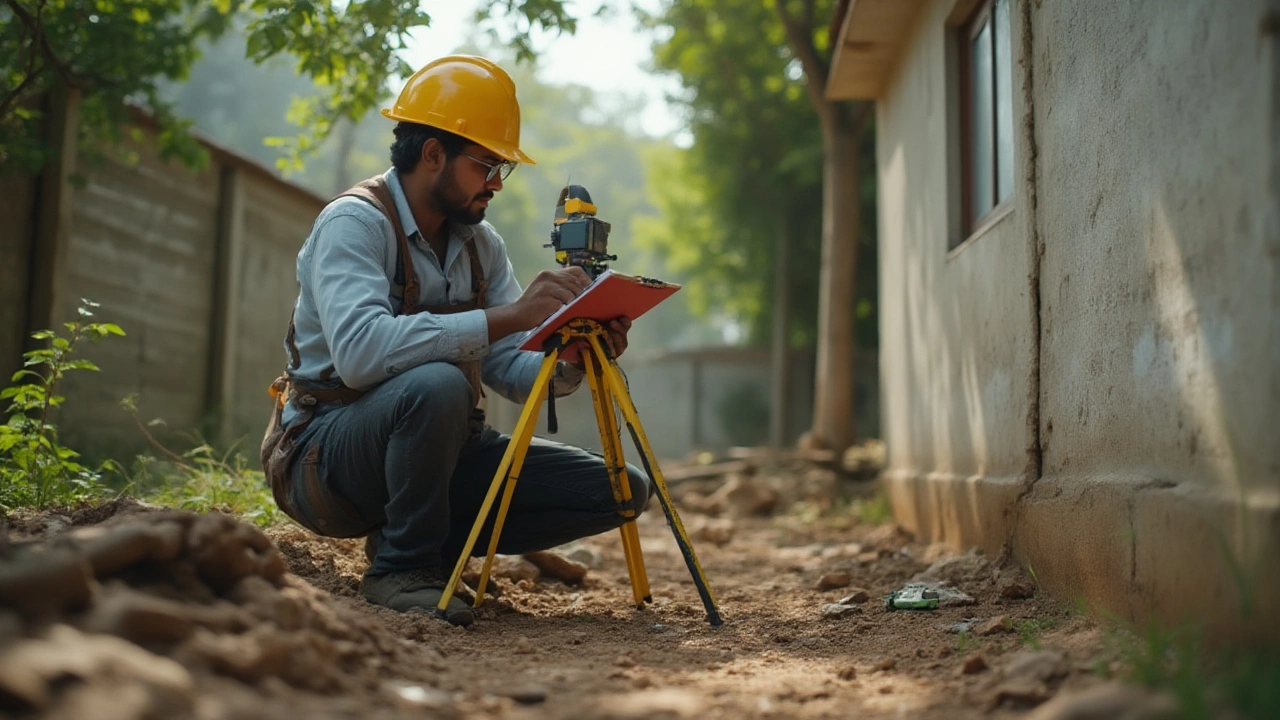Your living room floor started creaking, windows got cranky about closing, and there’s a tiny crack where the wall meets the ceiling. At first, you shrug it off. But that nagging feeling creeps in every time you spot another mysterious line snaking across the drywall. Foundation problems have a way of sneaking up, quietly threatening your property value, your safety, and your wallet. Think you’re the only one? Nope. U.S. homeowners fork out more than $4 billion a year fixing foundation issues. Some of these headaches could have been prevented—or cost way less—if folks had acted sooner. Before your walls start telling tales, here’s how to spot, handle, and eventually fix those foundation problems without losing your mind or every dime you own.
Why Foundation Problems Happen (And How to Spot Them)
Most people hear about foundation problems only after a neighbor’s entire porch tilts like a ship in rough seas. But it rarely happens overnight. Clay-rich soils, like those through much of Texas and the Midwest, expand and contract with wet and dry spells, heaving your home like a see-saw. Elsewhere, poor drainage, leaky plumbing, or simple age can wear down even the tightest concrete slab.
What does all this look like in real life? Here’s where to pay attention:
- Cracks in brickwork, especially the classic stair-step ones.
- Diagonal cracks running from window or door corners.
- Gaps under baseboards or door frames pulling away from the walls.
- Bouncy, sloping, or uneven floors—trust your feet; they know when something’s off.
- Sticky doors and windows.
- Cracks in the garage floor or driveway, but only worry if they spread or keep coming back after patching.
Small vertical cracks can be harmless, just part of your house settling in. But anything thicker than a pencil, especially if it’s wider at the top than the bottom, means the soil (or water, or roots, or time) has shifted something it shouldn’t have. And don’t ignore leaks in the basement; when water sneaks in, it often brings foundation trouble along.
Here’s a table breaking down some common causes, symptoms, and urgency levels:
| Cause | Symptom | Urgency |
|---|---|---|
| Soil Movement | Diagonal cracks, uneven floors | High |
| Poor Drainage | Water pooling, wall cracks | Medium |
| Plumbing Leaks | Foundation dampness, mildew | High |
| Tree Roots | Exterior cracks, shifted driveway | Low/Medium |
| Age/Settlement | Minor vertical cracks | Low |
Trust what you see. If you spot a pattern of growing cracks or movement, it's time to act. The cost of doing nothing usually goes up with every season you procrastinate.
What to Do First: Assessing the Damage
Notice a new crack or two and suddenly you’re channeling your inner Sherlock Holmes—measuring, taking photos, maybe even geeking out with a chalk line. First step, don’t panic. Most houses shift a little, especially the first few years. But if things keep changing, or the problems match the high-priority symptoms from the table, it’s worth a deeper look.
Here’s your damage-control crash course:
- Document Everything: Take dated photos of cracks, sticking windows, and anything suspicious. If you need a pro later, you’ll have proof of what changed and when.
- Track Problem Spots:
- Measure crack width with a ruler or index card—write it down and check again every couple weeks.
- Mark ends of cracks with a pencil. If the lines move, don’t ignore it.
- Walk the House:
- Check exterior and interior for new cracks, misaligned doors, or sagging floors.
- Don’t forget the garage and crawl space—termites love rotten sills and waterlogged beams.
- Check Drainage:
- Look outside when it’s pouring. Water should run away from the house, not pool near the foundation. Gutters and downspouts really do matter.
If cracks keep growing, or if your floor dips more than a half-inch over a short distance, call in a structural engineer or foundation specialist. Average inspections run $400-$800, but that’s cheap compared to fixing busted pipes or underpinning a whole wing of your house. If you already have water in the basement, get a pro ASAP. Even if it seems dry later, past leaks can spawn dangerous mold or hidden rot under the surface.
By the way, insurance rarely covers foundation problems unless you have specific riders for things like earthquake or flood. So waiting for a payout is usually a fast track to disappointment. Most foundation repair companies offer free or low-cost evaluations—and the extra time you spend researching can save you major headaches.

Fixing It: Foundation Repair Methods Explained
When the verdict’s in and you know the cause, there’s a menu of repairs—some straightforward, some heavy-duty. Here’s what might happen:
- Epoxy or Polyurethane Injections: For hairline cracks, contractors inject these glues to stop water and add strength. Fast, non-invasive, usually $400–$1,200 per crack, and doesn’t mess with your landscaping.
- Piering and Underpinning: If the soil under your house dropped or shifted, the fix often involves driving piers or steel posts through unstable soil down to bedrock or stable dirt. Expect to pay $1,000–$3,000 per pier. For a typical home, costs add up—sometimes well over $10,000.
- Slabjacking/Mudjacking: If parts of a concrete slab dropped, pros pump grout or foam below until it lifts back to level. This usually costs $500–$1,300 per area, great for settled porches and patios.
- Wall Anchors and Carbon Fiber Straps: Bowed or bulging basement walls get braced or pulled back into shape with steel plates and anchors sunk in your yard, or fiber straps bonded to the concrete inside. Anchors run $700–$1,000+ each—straps about half that, but only for minor movement.
- Drainage Solutions: French drains, new gutters, or simple soil grading all help keep water away. Good drainage is your first defense against future trouble, and costs from a few hundred bucks for gutter work up to $8,000+ for complex exterior waterproofing.
What about DIY? Sure, you can patch a crack, fix some grading, or unclog a gutter. But anything involving real lifting, plumbing, or structural changes needs a pro. Serious repairs can mess with utilities, home value, and safety—not the place to experiment and hope for the best.
Here’s a cost breakdown table for quick reference:
| Repair Type | Average Cost (USD) | When to Use |
|---|---|---|
| Epoxy Injection | $400 - $1,200 per crack | Small, non-structural cracks |
| Piering | $1,000 - $3,000 per pier | Major settlement, unstable soil |
| Slabjacking | $500 - $1,300 per section | Dropped slabs, patios |
| Anchor/Straps | $700 - $1,000+ per anchor | Bowing basement walls |
| Drainage | $500 - $8,000+ | Water issues, prevention |
Contracts matter. Avoid anyone who offers a quote without inspecting the house in-person. Real pros should guarantee their work—get it in writing, because you do not want to pay for the same repair twice. Most reputable companies will throw in a transferable warranty, which adds value if you ever sell.
Preventing Future Foundation Problems
Once your foundation is back in line, keep trouble from returning. Most of the best tricks are simple enough:
- Control Water:
- Downspouts should extend at least 6 feet from the foundation. Short ones dump water right where cracks want to form.
- Grade soil so it slopes away from the house. Aim for 1 inch of fall per foot for the first 6–10 feet.
- Install French drains or a sump pump in wet climates or if water likes to pool in your yard.
- Mind the Trees:
- Keep big trees at least 15–20 feet away from foundations, or their thirst for water will dry and shift the soil right under you.
- Trim back overgrown roots—if in doubt, hire an arborist, not a friend with a chainsaw.
- Fix Leaks Fast:
- Regularly inspect your basement, crawl space, and plumbing lines for leaks, weird smells, or mysterious damp spots.
- Routine Checks:
- Walk around the house after heavy rain or droughts, looking for new or growing cracks.
- If the ground feels extra soft near the foundation, poke around—it could mean a leaky pipe or poor drainage.
- Don’t Ignore Small Repairs:
- Patch minor driveway or walkway cracks. They invite water under your foundation, speeding up problems.
- Seal or caulk around basement windows and doors to keep water out—those products exist for a reason.
Foundation maintenance isn’t glamorous, but it beats digging up the yard while the neighbors rubberneck. If you live in an older or notoriously shift-prone area, yearly foundation inspections can save you thousands and keep your home solid. Even new homes aren’t immune—builders make mistakes, and soil never forgets to settle.
If you’re buying or selling, always get a foundation check. Real estate websites report that homes with documented repairs and transferable warranties sell up to 10% faster and close with fewer price negotiations. That’s real money back in your pocket instead of in the dirt beneath your house.
You, your house, and your sanity deserve strong ground to stand on. Stay vigilant, act early, and foundation problems won’t have a chance to own you or your wallet.

Written by Fletcher Abernathy
View all posts by: Fletcher Abernathy